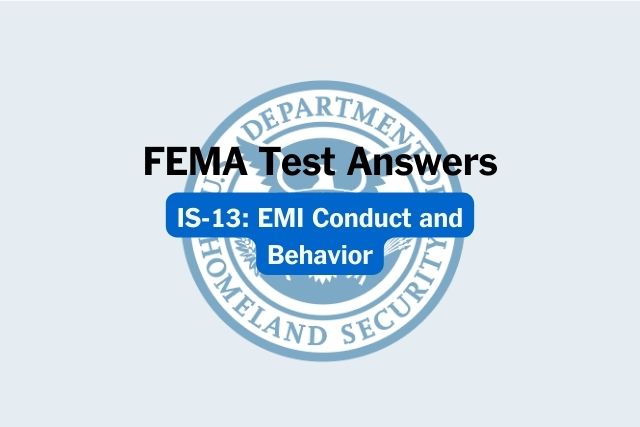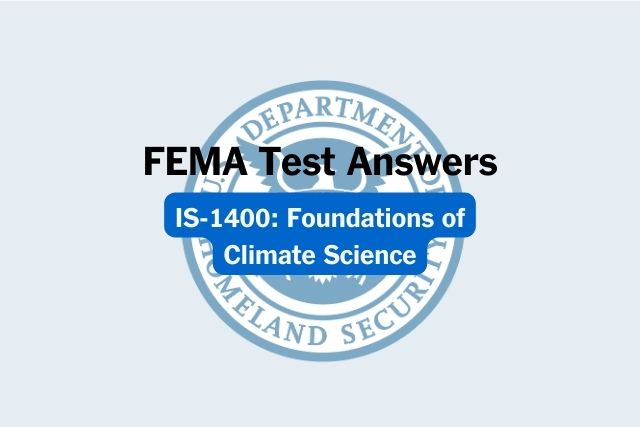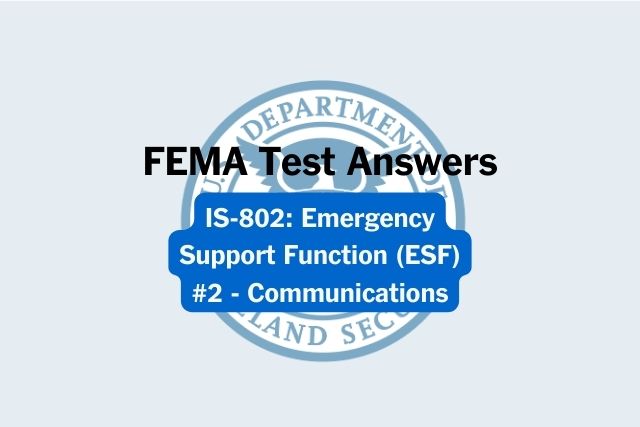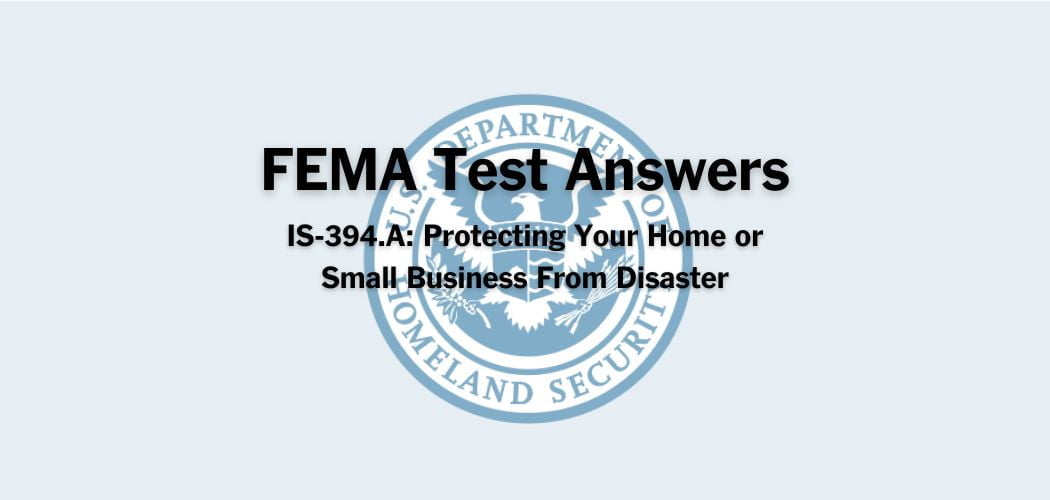The FEMA IS-450: Emergency Preparedness for Federal Employees course has been retired without a replacement.
FEMA IS-450 test answers
Question 1. Regardless of how you normally get to work, which of the following actions should you take to be prepared for an emergency?
A. Review various public transportation options that may get you home or to your family meeting place.
B. Keep a pair of comfortable walking shoes and a street map of the local area at work.
C. Familiarize yourself with available bus, subway, or rail lines, even if you normally drive to work.
D. All of the above✅
Question 2. Which of the following statements regarding NOAA Weather Radio (NWR) is false?
A. It is a nationwide network of radio stations broadcasting continuous weather information directly from a nearby National Weather Service office
B. It can be accessed directly via any radio device and is available regardless of where you live
C. It provides warnings for all types of hazards ‘ not just weather information✅
D. It broadcasts official Weather Service warnings, watches, forecasts, and other hazard information 24 hours a day, 7 days a week
Question 3. How should you prepare for an emergency at work?
A. Know how you will receive emergency alerts from your agency and local government
B. Maintain an emergency kit at work with essential items for at least 10 days
C. Learn the nearest exit route so you can immediately evacuate your work area in all emergencies
D. All of the above✅
Question 4. Which of the following statements is false?
A. Being prepared creates safe, secure, and resilient communities against terrorism and other hazards.
B. When individual Federal employees are prepared for emergencies, the Federal Government as a whole is better prepared to continue providing essential functions and services.✅
C. Federal employees can take basic steps now to lessen the effects of disasters, including acts of terrorism.
D. Being prepared can reduce the risk of natural disasters.
Question 5. Is the following true or false? “Generally, you will only shelter in place at the office until the threat can be assessed, emergency response personnel arrive, and the dangerous conditions pass. Once you feel that there is no longer a hazard, you are free to leave the shelter-in-place location, and you do not have to wait until an ‘all clear’ is issued by building management or security personnel.’
A. True
B. False✅
Question 6. How does preparing for emergencies enhance the safety of your family and strengthen your ability to carry out your work?
A. Being prepared reassures you that your family has a plan for emergencies.
B. Being prepared enables you and your family to know how to get critical updates during an emergency.
C. Being prepared reassures you that your family knows of alternate ways to communicate while you are at work.
D. All of the above✅
Question 7. What is the Community Emergency Response Team (CERT)?
A. CERT is a specialized part of the local fire department that has been certified by the National Fire Administration to manage large, community-wide disasters.
B. CERT is a team from the FEMA regional office that specializes in community outreach following a disaster.
C. CERT is a local city or county division of a FEMA Urban Search and Rescue (USAR) team.
D. CERT members are community volunteers who can give critical support to first responders, provide immediate assistance to victims, and organize spontaneous volunteers at the site of an emergency.✅
Question 8. ‘Getting involved’ focuses on finding opportunities to support community and workplace preparedness before an emergency occurs. Which of the following activities can help in this effort?
A. Joining the Occupant Emergency Team
B. Volunteering with a faith-based or community organization
C. Participating in the Community Emergency Response Team program
D. All of the above✅
Question 9. How should you establish a location for your family to meet in the event of an emergency?
A. Pre-designate a single-family meeting location so all family members will know where to go if they cannot communicate.
B. Pre-designate at least two family meeting locations: a place near your home, and a place outside the local area.✅
C. Each family member should select his or her own meeting location based on his or her own individual needs.
D. Each emergency is different ‘ do not pick a meeting location in advance.
Question 10. During an emergency, Federal agencies may close their facilities, but area-wide evacuation orders typically will come from which of the following?
A. Director of the Office of Personnel Management (OPM)
B. The White House
C. FEMA Administrator
D. Governor, mayor, or county official for the jurisdiction where the evacuation will take place✅
Question 11. Who is responsible for emergency preparedness?
A. Individual citizens are solely responsible for emergency preparedness.
B. Emergency response personnel and disaster relief organizations are solely responsible for emergency preparedness.
C. It is a shared responsibility of all levels of government, the private and nonprofit sectors, and individual citizens.✅
D. The Federal Government is solely responsible for emergency preparedness.
Question 12. Is the following statement true or false? “FEMA recommends that you check and update your emergency kit once a year.”
A. True
B. False✅
Question 13. The main purpose of the _______ is to communicate information effectively about terrorist threats by providing timely, detailed information to the public, government agencies, first responders, airports and other transportation hubs, and the private sector.
A. NOAA Weather Radio (NWR) network
B. National Terrorism Advisory System (NTAS)✅
C. Homeland Security Advisory System (HSAS)
D. Federal Executive Boards
Question 14. It is important to assemble an emergency supply kit prior to an emergency because:
A. You can take essential items with you if you need to evacuate quickly
B. Emergency response personnel may not be able to help you right away, so you may need to survive on your own for a while
C. Basic services such as electricity, gas, water, sewage treatment, and telephones may be cut off after the emergency
D. All of the above✅
Question 15. Following an emergency, why should you let your family know about your status via text message, e-mail, or social media sites?
A. Local telephone calls may not go through.
B. The telephone system may be overloaded with 911 calls.
C. You can communicate with multiple people at once.
D. All of the above✅
Question 16. Generally, if an emergency occurs while you are at work but you are not in immediate danger, your default action should be to___________.
A. Stay where you are and await further directions✅
B. Ignore the emergency so trained emergency response personnel can address the situation
C. Evacuate the building
D. Move to your designated shelter-in-place location
Question 17. Prior to an emergency, it is important to identify a friend or relative who can serve as an out-of-state contact because:
A. In an emergency, it may be easier to make a long-distance phone call than to call across town.
B. An out-of-town contact may be in the best position to communicate among separated family members.
C. It is less probable that an out-of-town contact will be affected by the same emergency situation facing you and your family members.✅
D. All of the above
Question 18. If the fire alarm goes off at work, what should you do immediately after evacuating the building?
A. Drive or take the next bus or train home to get far away from the emergency scene and allow first responders to work without interference
B. Go to your emergency assembly point and check in with your supervisor or other designated point of contact✅
C. Wait for instructions near the exit door of the building
D. Return to the building to retrieve your emergency preparedness kit
Question 19. Based on the current guidance from the Ready campaign and used throughout this course, what are the key steps to prepare for an emergency?
A. Buy a Kit, Make a Plan, Be Informed
B. Know Your Needs, Know Your Hazards, Know Your Plan
C. Make a Plan, Practice the Plan, Share the Plan
D. Be Informed, Make a Plan, Build a Kit, Get Involved✅
Question 20. Is the following statement true or false? “All Federal employees should have a personal emergency preparedness plan, even if they do not have designated emergency responsibilities.”
A. True✅
B. False



